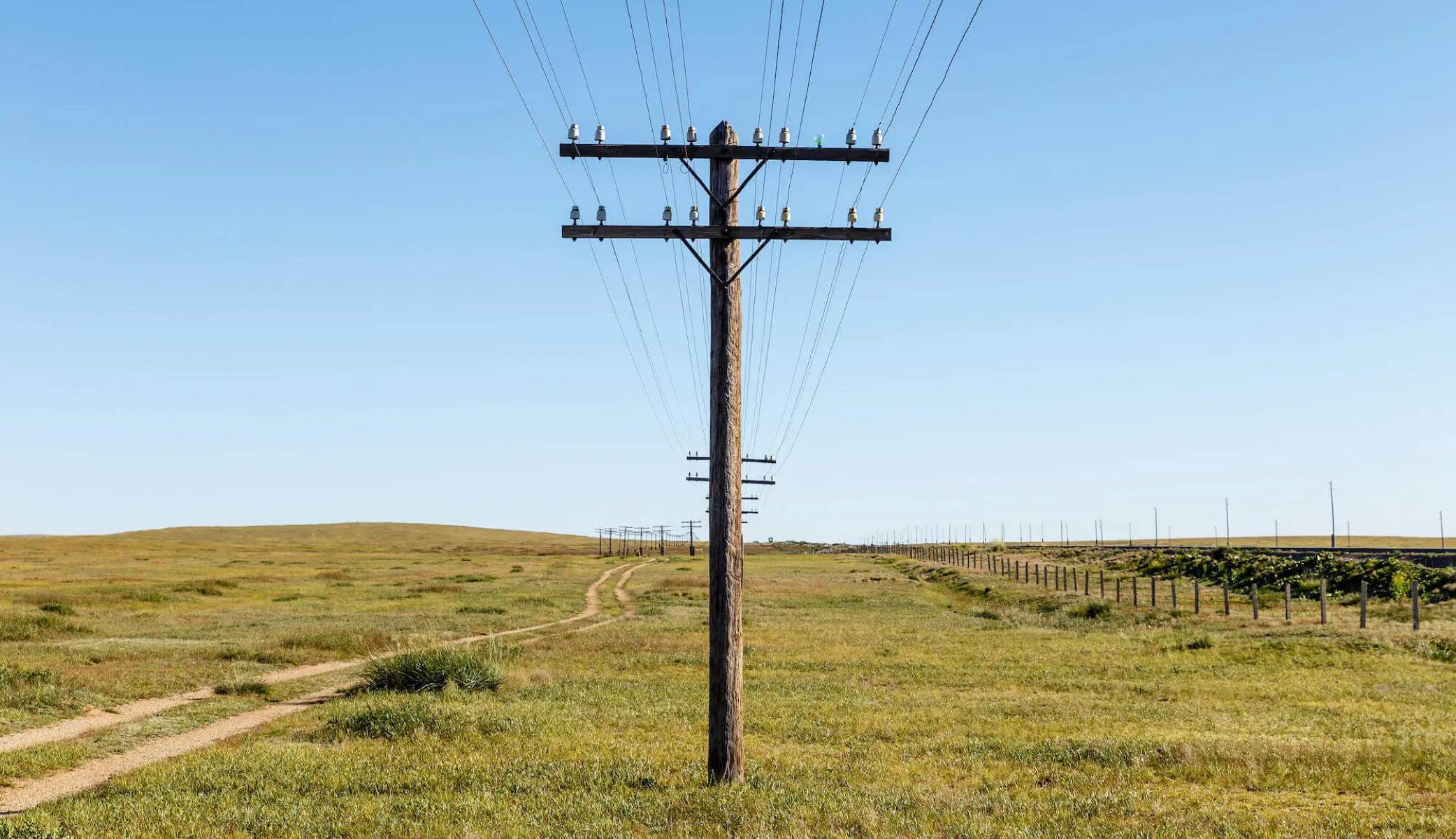Home>Real Estate>The Surprising Truth About Who Owns The Utility Pole On Your Property


Real Estate
The Surprising Truth About Who Owns The Utility Pole On Your Property
Published: February 10, 2024
Discover the truth about utility pole ownership on your property. Learn how it impacts real estate and property rights. Gain insight into who holds the power.
(Many of the links in this article redirect to a specific reviewed product. Your purchase of these products through affiliate links helps to generate commission for Regretless.com, at no extra cost. Learn more)
Table of Contents
Introduction
When you look out at the street from your property, you might notice the tall, sturdy utility poles that line the roadways. These poles play a crucial role in supporting the complex network of power lines, telecommunication cables, and other essential utilities that keep our modern world running smoothly. But have you ever wondered who actually owns the utility pole standing on your property?
The truth might surprise you. While it's easy to assume that utility poles are owned and maintained by the local government or municipality, the reality is often quite different. In many cases, utility poles are owned by private utility companies rather than being public property. This means that the responsibility for maintaining and servicing these poles falls on the shoulders of these utility companies, rather than the local government.
Understanding the ownership of utility poles is not just a matter of curiosity; it can have practical implications for property owners. It's essential to know your rights and responsibilities when it comes to the utility poles on your property, as well as the legal considerations and potential disputes that may arise.
In this article, we'll delve into the often-surprising truth about utility pole ownership, shedding light on the rights and responsibilities of property owners, the role of utility companies in accessing and maintaining these poles, and the legal considerations that come into play in the event of disputes. By the end, you'll have a comprehensive understanding of this often-overlooked aspect of property ownership, empowering you to navigate any related issues with confidence and clarity.
Understanding Utility Pole Ownership
Utility pole ownership is a complex and often misunderstood aspect of property rights. Many property owners assume that the utility poles situated on or near their land are owned and maintained by the local government or municipality. However, the reality is quite different. In most cases, these utility poles are owned by private utility companies, which are responsible for their installation, maintenance, and repair.
The ownership of utility poles is rooted in the concept of easements. An easement grants a particular party the legal right to use a portion of another person's property for a specific purpose. In the context of utility poles, utility companies typically hold easements that allow them to install and maintain poles and associated infrastructure on private property. These easements are crucial for ensuring that utility companies can access and service their equipment without infringing on the property rights of the landowner.
It's important to note that while utility companies own the poles themselves, the land on which the poles are situated remains the property of the landowner. This means that property owners retain ownership of the land beneath and around the utility poles, even though they do not own the poles themselves. Understanding this distinction is vital for property owners, as it impacts their rights and responsibilities concerning the use and maintenance of their land.
In some cases, multiple utility companies may have infrastructure on the same utility pole, further complicating the ownership and maintenance responsibilities. For example, a single utility pole may support power lines from an electric company, communication cables from a telecommunications provider, and possibly other equipment from additional utility providers. This shared usage underscores the intricate web of ownership and access rights that govern utility pole infrastructure.
Moreover, the location of utility poles on private property can have implications for property development and landscaping. Property owners must consider the presence of utility poles when planning construction or landscaping projects, as they must ensure that they do not interfere with the utility company's access to their equipment. Understanding the ownership of utility poles empowers property owners to navigate these considerations effectively and maintain compliance with relevant regulations.
In essence, understanding utility pole ownership involves recognizing the nuanced relationship between private utility companies and property owners. By comprehending the legal framework of easements and the division of ownership rights, property owners can make informed decisions regarding their land and effectively collaborate with utility companies to ensure the proper functioning and maintenance of utility pole infrastructure.
Rights and Responsibilities of Property Owners
Property owners hold specific rights and responsibilities concerning the utility poles situated on their land. Understanding these rights is crucial for navigating the complex landscape of utility pole ownership and ensuring compliance with relevant regulations. Here's a detailed look at the rights and responsibilities of property owners in relation to utility poles:
Property Rights
Property owners maintain ownership of the land on which utility poles are located, even though the poles themselves are typically owned by private utility companies. This ownership extends to the land beneath and around the utility poles, granting property owners the authority to utilize and develop their land within the constraints of relevant easements and regulations.
Access and Maintenance
While property owners have the right to use and develop their land, they must also respect the access needs of utility companies responsible for the utility poles. This includes allowing utility company personnel to access the poles for maintenance, repairs, and inspections. Property owners should refrain from obstructing or impeding the utility company's access to their equipment, ensuring that the infrastructure remains in proper working condition.
Compliance with Regulations
Property owners are obligated to adhere to regulations and guidelines related to the presence of utility poles on their land. This may include maintaining a clear zone around the utility poles to facilitate safe and unimpeded access for utility company personnel. Additionally, property owners must consider the presence of utility poles when planning construction or landscaping activities, ensuring that such endeavors do not interfere with the utility company's access to their equipment.
Communication with Utility Companies
Effective communication between property owners and utility companies is essential for addressing any concerns or issues related to utility poles. Property owners should maintain open lines of communication with the relevant utility companies, promptly reporting any observed damage or hazards associated with the utility poles. Likewise, utility companies should communicate proactively with property owners regarding planned maintenance or any necessary access to the utility poles.
Legal Considerations
Property owners should familiarize themselves with the legal framework governing utility pole ownership, including relevant easements and property rights. In the event of disputes or disagreements related to utility poles, property owners may need to seek legal counsel to ensure that their rights are upheld and that any conflicts are resolved in accordance with the law.
By understanding and embracing these rights and responsibilities, property owners can effectively manage the presence of utility poles on their land while fostering a cooperative and compliant relationship with the utility companies responsible for maintaining the infrastructure. This proactive approach not only promotes the proper functioning of utility pole infrastructure but also contributes to the overall safety and reliability of essential utility services for the community.
Utility Companies and Access to Utility Poles
Utility companies play a pivotal role in ensuring the accessibility, safety, and functionality of utility poles, which are essential components of the infrastructure supporting power distribution, telecommunications, and other vital services. Understanding how utility companies access and maintain utility poles is crucial for property owners and the general public. Here's an in-depth exploration of the dynamics surrounding utility companies and their access to utility poles:
Infrastructure Maintenance and Upkeep
Utility companies are responsible for the ongoing maintenance and upkeep of utility poles to guarantee the reliability and safety of essential services. This includes regular inspections to identify and address any signs of wear, damage, or deterioration. By proactively maintaining utility poles, utility companies uphold the integrity of the infrastructure, mitigating the risk of service disruptions and safety hazards.
Access Rights and Easements
Utility companies hold legal easements that grant them the right to access utility poles situated on private property. These easements are crucial for ensuring that utility company personnel can perform necessary maintenance, repairs, and inspections without infringing on the property rights of the landowner. Property owners must respect these access rights, facilitating unimpeded access to the utility poles while adhering to relevant regulations and guidelines.
Collaboration with Property Owners
Effective collaboration between utility companies and property owners is essential for addressing access-related concerns and ensuring the proper functioning of utility pole infrastructure. Utility companies should maintain open lines of communication with property owners, proactively informing them of any planned maintenance or access needs. Likewise, property owners should promptly report any observed damage or hazards associated with the utility poles, fostering a cooperative approach to infrastructure management.
Safety and Compliance
Utility companies adhere to stringent safety and compliance standards when accessing and servicing utility poles. This includes implementing safety protocols to protect both their personnel and the surrounding property. Additionally, utility companies must comply with regulations governing the installation and maintenance of utility pole infrastructure, promoting the safe and reliable delivery of essential services to the community.
Technological Advancements
Advancements in technology have enabled utility companies to enhance the monitoring and maintenance of utility poles. Innovative solutions, such as remote monitoring systems and predictive analytics, empower utility companies to proactively identify potential issues and optimize maintenance efforts, contributing to the overall efficiency and reliability of utility pole infrastructure.
By gaining insight into the mechanisms through which utility companies access and maintain utility poles, property owners and the public at large can appreciate the intricate processes involved in sustaining the essential infrastructure that powers modern society. This understanding fosters a collaborative and informed approach to utility pole management, ultimately contributing to the safety, reliability, and longevity of vital utility services.
Legal Considerations and Disputes
Legal considerations and potential disputes related to utility pole ownership can arise due to various factors, including property rights, easements, maintenance responsibilities, and compliance with regulations. Understanding the legal framework governing utility pole ownership is essential for property owners and utility companies alike, as it ensures that rights are upheld, and any conflicts are resolved in a fair and lawful manner.
Property Rights and Easements
Property owners must be aware of their property rights concerning the presence of utility poles on their land. While utility companies own the poles themselves, property owners retain ownership of the land on which the poles are situated. This distinction is crucial, as it delineates the boundaries of ownership and usage rights. Additionally, property owners should familiarize themselves with the specific easements that grant utility companies the legal right to access and maintain the utility poles. Understanding the scope and limitations of these easements is vital for navigating potential disputes and ensuring compliance with legal obligations.
Maintenance Responsibilities
Clarity regarding maintenance responsibilities is essential for preempting disputes related to the upkeep of utility poles. While utility companies are typically responsible for the maintenance and repair of the poles, property owners must refrain from actions that could impede or obstruct the utility company's access to their equipment. Conversely, utility companies must fulfill their maintenance obligations in a timely and effective manner, addressing any issues that may compromise the integrity or safety of the utility poles. By delineating these responsibilities clearly, potential disputes can be mitigated, and the infrastructure can be maintained effectively.
Compliance with Regulations
Both property owners and utility companies are obligated to comply with regulations governing utility pole ownership and maintenance. This includes maintaining clear zones around the utility poles to facilitate safe access and adhering to safety standards and guidelines. Failure to comply with these regulations can lead to disputes and legal complications, underscoring the importance of upholding regulatory requirements.
Resolution of Disputes
In the event of disputes related to utility pole ownership, property rights, or maintenance responsibilities, seeking legal counsel may be necessary to facilitate resolution. Legal professionals with expertise in property law and utility regulations can provide guidance and representation, ensuring that disputes are addressed in accordance with the law and established precedents. Alternative dispute resolution mechanisms, such as mediation or arbitration, may also be employed to achieve amicable resolutions outside of traditional litigation.
By proactively addressing legal considerations and potential disputes related to utility pole ownership, property owners and utility companies can foster a cooperative and compliant approach to infrastructure management. Clarity, communication, and adherence to legal principles are fundamental in mitigating disputes and upholding the rights and responsibilities of all parties involved.
Conclusion
In conclusion, the ownership of utility poles on private property is a multifaceted and often surprising aspect of property rights and infrastructure management. Understanding the dynamics of utility pole ownership, the rights and responsibilities of property owners, the role of utility companies, and the legal considerations surrounding this infrastructure is crucial for fostering a cooperative and compliant approach to management.
Property owners play a pivotal role in upholding their rights and responsibilities concerning utility poles. By recognizing their property rights, facilitating access for utility company personnel, complying with regulations, and maintaining open communication, property owners can contribute to the safety, reliability, and longevity of utility pole infrastructure. This proactive approach not only benefits the property owners themselves but also ensures the seamless delivery of essential utility services to the broader community.
Utility companies, in turn, bear the responsibility of accessing and maintaining utility poles to guarantee the integrity and functionality of essential services. By adhering to safety standards, leveraging technological advancements, and fostering collaboration with property owners, utility companies contribute to the overall efficiency and reliability of utility pole infrastructure, thereby enhancing the quality of service for consumers.
Legal considerations and potential disputes related to utility pole ownership underscore the importance of upholding property rights, adhering to easements, fulfilling maintenance responsibilities, and complying with regulations. By navigating these aspects in a transparent and lawful manner, property owners and utility companies can mitigate disputes and ensure that infrastructure management aligns with legal principles and established precedents.
In essence, the surprising truth about utility pole ownership on private property illuminates the interconnectedness of property rights, infrastructure management, and community welfare. By embracing this understanding, property owners and utility companies can collaborate effectively, uphold their respective rights and responsibilities, and contribute to the seamless operation of utility pole infrastructure for the benefit of all stakeholders.
Ultimately, a cooperative and informed approach to utility pole ownership fosters a harmonious relationship between property owners and utility companies, ensuring the reliability, safety, and longevity of the infrastructure that underpins essential utility services.











